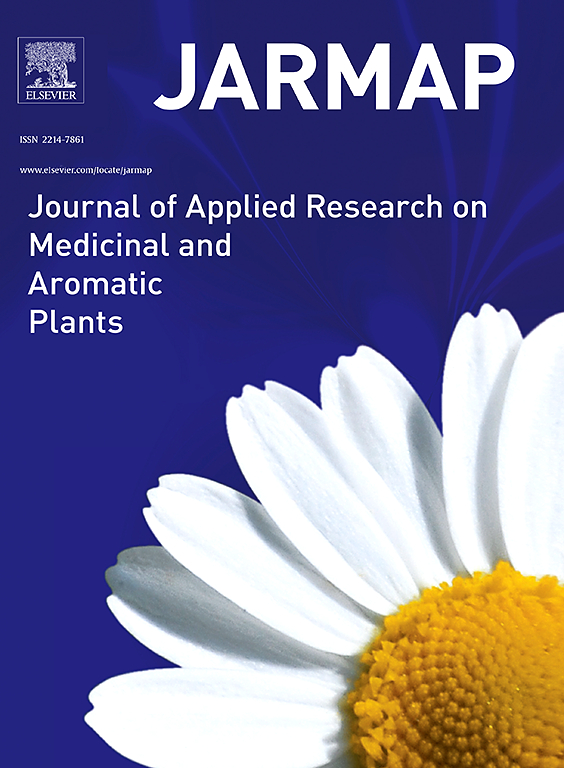药用和芳香植物剩余生物质的回收:生物精炼厂的一个有价值的替代方案
IF 3.6
2区 农林科学
Q1 PLANT SCIENCES
Journal of Applied Research on Medicinal and Aromatic Plants
Pub Date : 2025-01-17
DOI:10.1016/j.jarmap.2025.100624
引用次数: 0
摘要
药用和芳香植物(MAPs)部门产生了大量的残余废弃生物质,需要通过有效的资源回收利用并减少环境负荷。在本研究中,对6种芳香植物和2种药用植物的残留生物量进行了官能团、表面形态、结晶度、热性质、生化(纤维素、半纤维素和木质素)和元素分析(宏量和微量营养素)的鉴定,以了解它们作为不同生物精炼潜力的最佳替代用途,如生物乙醇、生物炭、堆肥、富含生物活性的提取物和生长介质。生物化学和元素特征为基于其可能用途的生物质的主要分组提供了定量数据,并得到了功能,形态表征,结晶度和热行为分析的定性(或半定量)数据的支持。柠檬草、棕榈草、爪哇香茅、皂荚和ashwagandha等map的生物量具有较高的纤维素和半纤维素含量(结构、结晶和生化信息),可用于制备生物乙醇。另一方面,圣罗勒、甜罗勒、薄荷和伊莎贝尔等结构芳香性和热稳定性较高的生物质适合开发生物炭。元素谱分析表明,圣罗勒、甜罗勒、薄荷和伊莎贝尔生物量适合其堆肥潜力。根据生物化学、功能和形态分析,所有生物量似乎都是有用的培养基制备。合并不同的表征技术被认为是合理的,以了解剩余生物量的最佳替代品。因此,本研究有助于制定生物精炼厂模式下的生物质完全循环利用策略,倡导循环经济。本文章由计算机程序翻译,如有差异,请以英文原文为准。
Recycling of residual biomass of medicinal and aromatic plants: A valuable alternative towards bio-refinery
A large amount of residual waste biomass is generated from medicinal and aromatic plants (MAPs) sector that needs to be utilized through effective recycling as resources and to reduce environmental load. In this study, identification of functional groups, surface morphology, nature of crystallinity, thermal property, biochemical (cellulose, hemicellulose and lignin), and elemental profiling (macro and micro nutrients) was carried out in residual biomasses of six aromatic and two medicinal plants to understand their best alternate use as different bio-refinery potential such as bioethanol, biochar, compost, bioactive rich extract, and growth medium. The biochemical and elemental profile provided quantitative data for primary grouping of the biomasses based on their possible usage that was supported by qualitative (or semi-quantitative) data from functional, morphological characterization, analysis of crystallinity and thermal behaviour. The biomass of MAPs like lemongrass, palmarosa, java citronella, isabgol and ashwagandha had higher cellulose and hemicellulose content (structural, crystalline and biochemical information), make them useful for preparing bioethanol. On the other hand, biomasses with high aromaticity and thermal stability in their structure like- holy basil, sweet basil, menthol mint and isabgol, found suitable towards development of biochar. Elemental profile showed suitability of holy basil, sweet basil, menthol mint and isabgol biomass for their composting potential. All biomasses seemed to be useful for growth medium preparation based on biochemical, functional and morphological analysis. Amalgamation of different characterization techniques were found rational to understand the best alternative(s) for residual biomasses. Thus, this study helps to develop a strategy for complete recycling of biomasses under model bio-refinery, which also advocate circular economy.
求助全文
通过发布文献求助,成功后即可免费获取论文全文。
去求助
来源期刊

Journal of Applied Research on Medicinal and Aromatic Plants
Pharmacology, Toxicology and Pharmaceutics-Drug Discovery
CiteScore
6.40
自引率
7.70%
发文量
80
审稿时长
41 days
期刊介绍:
JARMAP is a peer reviewed and multidisciplinary communication platform, covering all aspects of the raw material supply chain of medicinal and aromatic plants. JARMAP aims to improve production of tailor made commodities by addressing the various requirements of manufacturers of herbal medicines, herbal teas, seasoning herbs, food and feed supplements and cosmetics. JARMAP covers research on genetic resources, breeding, wild-collection, domestication, propagation, cultivation, phytopathology and plant protection, mechanization, conservation, processing, quality assurance, analytics and economics. JARMAP publishes reviews, original research articles and short communications related to research.
 求助内容:
求助内容: 应助结果提醒方式:
应助结果提醒方式:


